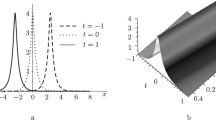Abstract
We study the two-component Kundu–Eckhaus equation with a zero boundary condition at infinity. Based on the spectral analysis of the Lax pair, a Riemann–Hilbert problem is established. An \(N\)-soliton solution is then obtained by solving the regular and nonregular Riemann–Hilbert problems.



Similar content being viewed by others
References
X.-G. Geng and H.-W. Tam, “Darboux transformation and soliton solutions for generalized nonlinear Schrödinger equations,” J. Phys. Soc. Japan, 68, 1508–1512 (1999).
X.-G. Geng, “A hierarchy of non-linear evolution equations its Hamiltonian structure and classical integrable system,” Phys. A, 180, 241–251 (1992).
Y. Kodama, “Optical solitons in a monomode fiber,” J. Statist. Phys., 39, 597–614 (1985).
A. Kundu, “Landau–Lifshitz and higher-order nonlinear systems gauge generated from nonlinear Schrödinger-type equations,” J. Math. Phys., 25, 3433–3438 (1984).
G. Tu, “Liouville integrability of zero curvature equations,” in: Nonlinear Physics (Proceedings of the International Conference, Shanghai, China, April 24 – 30, 1989, Research Reports in Physics, C. Gu, Y. Li, and G. Tu, eds.), Springer, Berlin (1990), pp. 2–11.
D.-S. Wang and X. Wang, “Long-time asymptotics and the bright \(N\)-soliton solutions of the Kundu–Eckhaus equation via the Riemann–Hilbert approach,” Nonlinear Anal. Real World Appl., 41, 334–361 (2018).
L.-L. Wen and E.-G. Fan, “The Riemann–Hilbert approach to focusing Kundu–Eckhaus equation with non-zero boundary conditions,” Modern Phys. Lett. B, 34, 2050332, 20 pp. (2020).
C.-H. Gu, H.-S. Hu, and Z.-X. Zhou, Darboux Transformations in Integrable Systems. Theory and their Applications to Geometry, (Mathematical Physics Studies, Vol. 26), Springer, New York (2005).
V. B. Matveev and M. A. Salle, Darboux Transformations and Solitons, (Springer Series in Nonlinear Dynamics, Vol. 5), Springer, Berlin (1991).
V. F. Zakharov and A. B. Shabat, “Exact theory of two-dimensional self-focusing and one-dimensional self-modulation of waves in nonlinear media,” Soviet Phys. JETP, 34, 62–69 (1972).
K. Kawata, “Riemann spectral mathod for the nonlinear evolution equation,” in: Advances in Nonlinear Waves, Vol. 1 (L. Debnath, ed.), Pitman, Boston, MA (1984), pp. 210–225.
S. P. Novikov, S. V. Manakov, L. P. Pitaevski and V. E. Zakharov, Theory of Solitons: The Inverse Scattering Method, Plenum, New York (1984).
J.-P. Wu and X.-G. Geng, “Inverse scattering transform and soliton classification of the coupled modified Korteweg–de Vries equation,” Commun. Nonlinear Sci. Numer. Simul., 53, 83–93 (2017).
D.-S. Wang, D.-J. Zhang, and J. Yang, “Integrable properties of the general coupled nonlinear Schrödinger equations,” J. Math. Phys., 51, 023510, 17 pp. (2010).
J. K. Yang, Nonlinear Waves in Integrable and Nonintegrable Systems, (Mathematical Modeling and Computation, Vol. 16), SIAM, Philadelphia, PA (2010).
G. Biondini and G. Kovačič, “Inverse scattering transform for the focusing nonlinear Schrödinger equation with nonzero boundary conditions,” J. Math. Phys., 55, 031506, 22 pp. (2014).
L.-L. Wen, N. Zhang, and E.-G. Fan, “\(N\)-soliton solution of the Kundu-type equation via Riemann– Hilbert approach,” Acta Math. Sci., 40, 113–126 (2020).
Funding
This research is supported by the National Natural Science Foundation of China (grant No. 11871138).
Author information
Authors and Affiliations
Corresponding author
Ethics declarations
The authors declare no conflicts of interest.
Additional information
Prepared from an English manuscript submitted by the author; for the Russian version, see Teoreticheskaya i Matematicheskaya Fizika, 2022, Vol. 212, pp. 386–402 https://doi.org/10.4213/tmf10171.
Rights and permissions
About this article
Cite this article
Wang, C., Zhang, J. Riemann–Hilbert approach and \(N\)-soliton solutions of the two-component Kundu–Eckhaus equation. Theor Math Phys 212, 1222–1236 (2022). https://doi.org/10.1134/S0040577922090057
Received:
Revised:
Accepted:
Published:
Issue Date:
DOI: https://doi.org/10.1134/S0040577922090057



